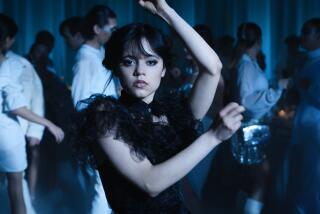Horror of the Crime Can Even Affect Young Eyes
- Share via
The O.J. Simpson case has exposed small children to another bloody televised episode in our violent society.
Certainly there is plenty of violence on TV without the Simpson story, both in the news and on dramatic shows. But because of the horror of this particular crime and the fame of the accused, the images produced by the Simpson trial might have more impact on a 5-year-old mind than some of TV’s other violent offerings.
*
With my own children grown, I hadn’t thought about this until I heard from someone who has spent much of her life communicating with children through television--Shari Lewis, alter ego to the famous puppet known as Lamb Chop.
Like so many of us, Lewis has been watching the Simpson murder trial. And she’s been thinking about the impact of such violent news on children, particularly those from 3 to 7 years of age, when they are especially impressionable.
“The descriptions [in testimony] are awful,” she said. “I have just come back from a week up in the mountains, where I was doing my writing, and in the evenings I would turn it on. The descriptions are grisly and I think children particularly identify with this because of [Simpson’s] two children and the football player.”
Would a small child watch the trial or even the evening summaries? “If the set is on, the kids sit there mesmerized,” Lewis said. “Kids get stoned, just like adults do, on TV.
“The set is on a great deal in most homes. What is happening [in the trial] is not boring. It is particularly fascinating to a generation brought up on police shows. This is even true for 5-year-olds. The car chase was fascinating.”
*
It was the 1992 riots, Lewis said, that first made her think seriously about the impact of violent news events on very young viewers.
Public television programmers asked her to make a series of spots to ease children’s fears. “This is a disaster for the children of Los Angeles and disturbing to children all over the country,” one PBS executive told her.
“I called all the experts,” she said. “What was fascinating was the wide variety of opinions. Some were punitive. They wanted me to deal with the fact that rioting was bad. Others wanted me to deal with the fact that there were causes.
“I felt neither was relevant. So I stuck with the core of love and comfort, which may seem saccharine, but if a child feels safe and loved, the child can weather anything.”
The spots starred Lewis and Lamb Chop.
“Lamb Chop, what’s bothering you?” Lewis asked in one of them.
“You’ll think it’s dumb,” Lamb Chop replied. “I know it’s only TV, but what I saw where people are fighting and burning things, it made me scared.”
“I’m so glad you told me,” said Lewis. “You know, you can tell me and ask me anything you want, any time you want to. And we can talk about it again and again, next week or next month.”
Then Lewis looked into the camera, addressing her young audience, and said: “Have you talked about it? What grown-up do you trust the most? Talk to that person about the way you’re feeling. Nobody’s going to think you’re silly.”
In another, Lamb Chop asked, “I saw people on television fighting and hurting each other. Why were they doing that?”
“They were angry,” Shari Lewis replied. “And sometimes when people are angry they forget to use words. Not just children, grown-ups forget to use words, too, and they strike out and hurt each other. Sometimes when everybody is angry you can get caught up in the anger and ideas about what is right or wrong get all blurry and you don’t know what to do. It’s very hard to remember to use words instead of acting it out.”
When Lewis made those spots, she didn’t expect that the riots would be followed by more disasters. “Don’t think the fires weren’t terrifying,” she said. “And the earthquake became a recurring nightmare.”
When the murders of Nicole Brown Simpson and Ronald Goldman are considered as part of a chain of violent events, she said, they become even more frightening.
*
Consider the images of the Simpson case. There is the tarnished hero. Another is race. A third is domestic abuse, a sad part of the lives of many children.
And, finally, the Simpson trial offers almost daily glimpses of the most frightening thought of all--a mother gone away, never to return.
Just think about this from the standpoint of a child. It is another example of how the ripple effect of the heavily publicized Simpson trial extends deep into our society.
More to Read
The complete guide to home viewing
Get Screen Gab for everything about the TV shows and streaming movies everyone’s talking about.
You may occasionally receive promotional content from the Los Angeles Times.






